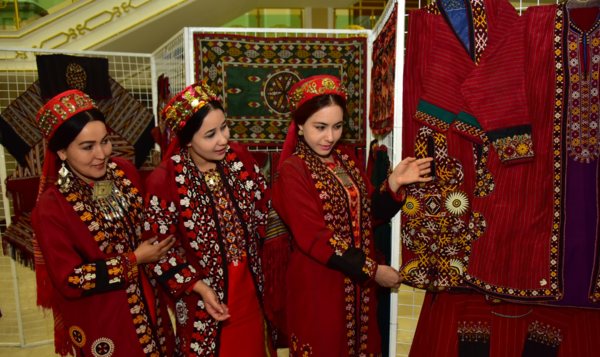News
Turkmen Style Needlework Art
- NameKuvvat Mamedov
- Date22 Jan 2024
- CategoryICH News

In the life of Turkmen people, the great importance of decorating clothes with embroidery has led to the creation of various types of patterns and the perfection of this handicraft to the level of art. Embroidery handicraft takes its origin from the depths of history and is considered to be one of the most widespread and ancient arts in the world. In the East, particularly in India, China, Japan, and Central Asia, girls and women were always engaged in embroidery. As known, in India and the Islamic world, costumes were decorated with silk, cotton, gold, and silver polished colored threads; in China and Japan, they are embroidered with silk threads of various colors. Turkmen women used cotton and silk threads to decorate their clothes.
In the patterns, they embroidered unique images of plants, birds, and the wonderful beauties of nature. Girls and women described not only the beauties of nature through their embroidery, but they also expressed their dreams and desires. They laughed, told jokes, and competed with each other while doing handicrafts. Only some people were able to make the embroidery masterfully. Only spiritually strong, deeply sensitive women were able to create high-quality models of that craft. Through the embroidery, they could also determine the character of the woman who created it. Among girls and women, making embroidery is considered to be the most delicate work, and they explain that it is "as if digging a well with the help of the needle" that requires much labor.
Handmade embroideries are considered the pride and dignity of Turkmen women. So, masterful embroiderers immediately became famous among girls and women. They have earned a special reputation and become famous for their national costumes, which they have masterfully embroidered.

Throughout history, they have managed to develop any type of craftsmanship and raised it to the model level. In the family, a girl’s ability to do handicrafts was considered to be a special part of her upbringing. From an early age, girls were taught delicate secrets of making such handicraft methods as keshde and gayma. That is why a girl who was brought up in an industrious family starts doing handicrafts by using a needle in her hand. She begins with the simplest way of doing handicrafts, and finally, she fulfills all the requirements of the handicrafts and begins making embroideries professionally.
On the other hand, the handicrafts developed by our women are one of the most perfect national cultural values that have made a significant contribution to the development of world culture. From ancient times our grandmothers developed various techniques of handicrafts, from simple methods like tack (a long stitch used to fasten fabrics together temporarily, prior to permanent sewing) to such complicated methods as "keshde," "gayma," "kojume," "lime," "chigme," "basma," "depjeme" and "pugtama" and perfected them by handing them down from mother to daughter, from mother-in-law to daughter-in-law.
Doing such handicraft as “keshde” and “gayma” is the core of the life of Turkmen girls and women. Among Turkmen women, no one can’t do such handicrafts as keshde and gayma. Also, our women have created several embroidery patterns by adorning their clothes. They paid much attention to the beauty and wonders of nature. If the patterns “gochak,” “ukujy,” “tarim,” “labyr,” “pishme,” “tarim gozenek,” “atanak,” “gulmekan,” “tamdyragulak” describe Turkmen life then “alaja,” “dogajyk,” “dagdan,” “tegbent” patterns were believed to protect from misfortune, evil eye. Through the patterns “erikgul,” “almagul,” “gul,” “bossa- ny,” “chigildem,” “gulyaydy” the flowery image of spring was described and “ichyanagyz,” “gushdyrnak,” “bilbiljik,” “chynaryaprak,” “yyłanyoly,” “tolkun,” “tolkungochak,” “akyagysh,” “aksuv” patterns meant the beauty of Turkmen nature. The patterns of keshde, based on the hunting profession, were named “okgozi,” “peykam,” “sapancha.”
Turkmen-style needlework art has always been highly valued for its unique beauty and elegance and made a tremendous contribution to the development of global culture.
QUICK MENU
QUICK MENU 원하시는 서비스를 클릭하세요!
There is no registered quick menu.